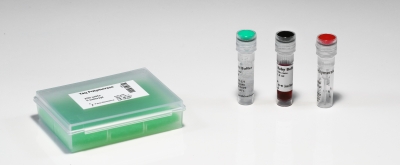Thermostable DNA Polymerase
Thermus aquaticus, recombinant, E. coli
| Cat. No. | Amount | Price (EUR) | Buy / Note |
|---|---|---|---|
| PCR-421-1KU | 1 kilo unit | 248,90 | Add to Basket/Quote Add to Notepad |
| PCR-421-10KU | 10 kilo units | 1.168,70 | Add to Basket/Quote Add to Notepad |
| PCR-421-100KU | 100 kilo units | Ask for Quotation |

For general laboratory use.
Unit Definition: One unit is defined as the amount of the enzyme required to catalyze the incorporation of 10 nmoles of dNTP's into an acid-insoluble form in 30 minutes at 70 °C using hering sperm DNA as substrate.
Shipping: shipped on gel packs
Storage Conditions: store at -20 °C
avoid freeze/thaw cycles
Shelf Life: 12 months
Form: liquid
Concentration: 100 units/μl
Description:
Taq Polymerase - high conc. is recommended for use in freeze drying applications as alternative to glycerol-free polymerase or in applications where only a minimal amount of volume can be used. The remaining glycerol concentration in the final assay is neglectable due to a high dilution factor.
The polymerase is recommended for routine PCR applications (up to 4 kb fragment length) or high throughput PCR.
The enzyme replicates DNA at 72 °C. It catalyzes the polymerization of nucleotides into duplex DNA in 5'→3' direction in the presence of magnesium. It also possesses a 5'→3' polymerization-dependent exonuclease replacement activity but lacks a 3'→5' exonuclease (proof-reading) activity.
Content:
Reaction Buffer and Nucleotides are not included. Please refer to our sections Buffers & Components and Nucleotides.
Taq Polymerase
100 units/μl Taq DNA Polymerase in 20 mM Tris-HCl, 100 mM KCl, 0.1 mM EDTA, 1 mM DTT, stabilizers, 50 % (v/v) Glycerol, pH 8.0 (25°C)
Assay Set-Up:
Before starting, thaw up all components and vortex thoroughly to ensure homogeneity.
| component | final assay conc. |
| PCR-grade Water | fill up to final amount |
| Reaction Buffer | 1 x |
| dNTP Mix | 200 μM |
| Taq Polymerase | 0.025-0.05 units/μl |
| primer mix or each primer | 200-400 nM each primer |
| template/sample DNA | < 10 ng DNA/assay |
Cycling Conditions:
Spin down the tubes/plate briefly to remove bubbles and place them into the cycler.
| initial denaturation | 95 °C | 2 min | 1 x |
| denaturation annealing 1) elongation 2) | 95 °C 50-68 °C 72 °C | 10-20 sec 10-20 sec 20 sec - 4 min | 25-30 x |
Recommended Buffer Systems:
Ruby Buffer (#PCR-272) includes a density reagent + tracking dye and allows the direct loading of the PCR products into an electrophoresis gel. For DNA detection / fluorescent DNA staining, we recommend to use new generations dyes (i.g. SYBR DNA Stain, #PCR-273) instead of the classical but highly mutagenic ethidium bromide.,
Crystal Buffer (#PCR-271) is recommended for down-stream applications such as DNA sequencing, ligation, restriction digestion or where an analysis of the PCR product by absorbance or fluorescence excitation is required. For gel electrophoresis add gel loading buffer and fluorescent DNA stain (i.g. Gel Loading Buffer with DNA Stain, #PCR-274 - #PCR-276) before loading the PCR into the gel. Using pre-stained gels or post-run staining protocols is also possible.,
KCl Buffer (#PCR-262) is recommended for use in routine PCR reactions. The buffer is optimized for highest specificity but may require additional fine-tuning of assay parameters like MgCl2 concentration and annealing temperature.,
Labeling Buffer (#PCR-263) is recommended for DNA labeling or mutagenesis applications. The buffer is specially optimized for incorporation of labeled or modified nucleotides into DNA. It gives superior results in a broad range of reaction conditions with most primer-template pairs but amplification may also tend to an increased inaccuracy.
Optimization of MgCl2 concentration:
MgCl2 Solution - 25 mM (#PCR-266) is recommended for optimization of the final Mg2+ concentration. A concentration of 1.5-2.0 mM is required for optimal functionality. Lower concentrations give higher specificity, whereas higher concentrations give higher yield.
Related products: